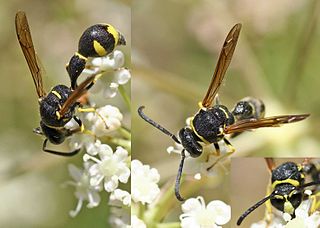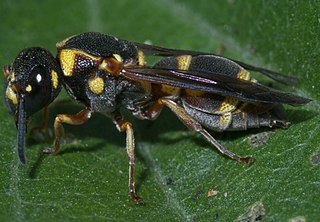
Polistes is a cosmopolitan genus of paper wasps and the only genus in the tribe Polistini. Vernacular names for the genus include umbrella wasps, coined by Walter Ebeling in 1975 to distinguish it from other types of paper wasp, in reference to the form of their nests, and umbrella paper wasps. Polistes is the single largest genus within the family Vespidae, with over 200 recognized species. Their innate preferences for nest-building sites leads them to commonly build nests on human habitation, where they can be very unwelcome; although generally not aggressive, they can be provoked into defending their nests. All species are predatory, and they may consume large numbers of caterpillars, in which respect they are generally considered beneficial.

Eumenes is the type genus of the subfamily Eumeninae of Vespidae. It is a large and widespread genus, with over 100 taxa, mostly occurring in the temperate portions of the Northern Hemisphere. Most species are black or brown, and commonly marked with strikingly contrasting patterns of yellow, white, orange, or red. Like most vespids, their wings are folded longitudinally at rest. The first metasomal segment is narrow and elongated, creating a "bulbous" appearance to the abdomen.

Montezumia is a primarily neotropical genus of eumenine wasps whose 48 species range from Argentina to the southwestern United States (Arizona). Most of the known species are from South America. Unfortunately, the behaviour of Montezumia species has been described for only eight definitively identified species.

Anterhynchium is an Afrotropical, Indomalayan, Australian and Palearctic genus of potter wasps. As in many species of wasp, female wasps defend against predation using a modified ovipositor to sting predators. Like some other wasps in the Vespidae family, male wasps can produce a "pseudo-sting" with two sharp spines on either side of their genitals; however, unlike in the females, this "sting" is venomless.

Delta is an Old World genus of potter wasps with species predominantly distributed through tropical Africa and Asia. Some species are present in the Palearctic region, and a few have been introduced in the Nearctic and Neotropical regions. The members of this genus have a long metasomal petiole, like members of the genera Eumenes and Zeta.

Katamenes is a genus of potter wasps with species distributed in Europe and Africa. When originally named by Edmund Meade-Waldo, Katemenes was monotypic, containing only K. watsoni, but other species have since been moved from Eumenes to Katamenes.
Hypodynerus is a South American, primarily Andean, genus of potter wasps with most of its described species inhabiting Chile. The species included in Hypodynerus include:
Discoelius is a palearctic genus of potter wasps with seven currently known species. It contains the following species:
Subancistrocerus is an Australian, Indomalayan, African and Palearctic genus of potter wasps. Males of this genus used to have an enlarged antennal tip.

Stenodynerus is a rather large genus of potter wasps whose distribution spans the Nearctic, Palearctic, Oriental and Neotropical regions. Most of its species lack a transverse carina on the first metasomal tergum. A pair of medial pits on the anterior face of the pronotum and the expansion of the tegulae put this genus close to genera as Parancistrocerus, Hypancistrocerus and Eustenancistrocerus.
Knemodynerus is a genus of potter wasps distributed through the Palearctic, Afrotropical, Indomalayan and Australasian regions. The species currently classified in the genus are:

Rhynchium is an Australian, Afrotropical, Indomalayan and Palearctic genus of potter wasps.

Polybia is a genus of eusocial wasps ranging from Central to South America. Some produce enough honey to be collected and eaten by local people.
Eustenancistrocerus is an Afrotropical, Palearctic and Oriental genus of potter wasps. The species in this genus include:
Ischnogasteroides is an Afrotropical and Palearctic genus of potter wasps. It currently includes the following species:
Micreumenes is an Afrotropical genus of potter wasps with 30 described species.

Pterocheilus is an essentially holarctic genus of potter wasps with a fairly rich diversity in North America and a single Afrotropical species Pterocheilus eurystomus Kohl 1906 known from Socotra. They are usually rather large wasps characterized by reduced tegulae and prominently pilose labial palpi.
Pseudonortonia is a fairly large genus of potter wasps with a rich Afrotropical fauna, as well as with several species which occur throughout the Palearctic and Indomalayan regions.










